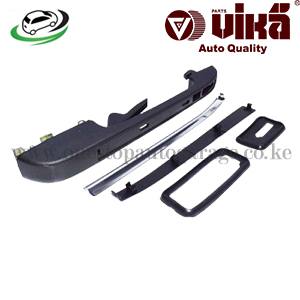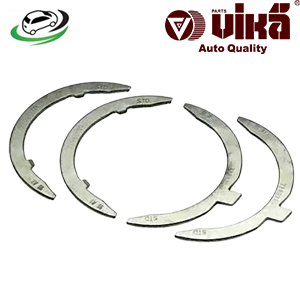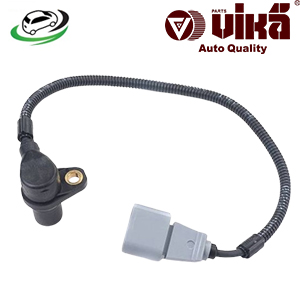-23%
Get Crankshaft Position Sensor Audi A3 8P V6 3.2L/ Audi Q7 V6/ Audi TT MKI/ Audi TT MKII/ VW EOS/Eurovan T4/R32 MKIV/Touareg 1/2 022957147A
The crankshaft position sensor is typically a small, robust device designed to withstand the harsh conditions of the engine environment. It is usually located near the crankshaft, often positioned at the front or side of the engine block, or inside the engine near the flywheel. The construction of the CPS includes several key components:
- Sensor Housing:
- The sensor housing protects the internal components from heat, vibrations, and contaminants such as oil and dirt. It is usually made from durable materials like plastic, aluminum, or steel.
- Sensing Element:
- The core component of the CPS is the sensing element, which detects the position and rotational speed of the crankshaft. Depending on the type of sensor, the sensing element may be a magnetic, Hall effect, or inductive element.
- The sensing element generates an electrical signal that corresponds to the movement of the crankshaft.
- Magnet or Reluctor Ring:
- In many CPS designs, a magnet or reluctor ring is attached to the crankshaft or flywheel. As the crankshaft rotates, the magnet or reluctor ring passes by the sensing element, inducing an electrical signal.
- Connector and Wiring:
- The CPS is connected to the vehicle’s ECU via a wiring harness. The electrical signals generated by the sensor are transmitted through these wires to the ECU.
- The connector is designed to withstand engine vibrations and temperature fluctuations, ensuring a reliable connection.
- Mounting Bracket:
- The CPS is secured to the engine block or other mounting points using a bracket or flange. Proper alignment and secure mounting are essential for accurate sensor readings.
Types of Crankshaft Position Sensors
There are several types of crankshaft position sensors, each with a different method of operation:
- Magnetic Sensor:
- Also known as a variable reluctance sensor, this type uses a permanent magnet and a coil of wire to detect the position of the crankshaft.
- As the reluctor wheel (attached to the crankshaft) passes by the sensor, it disrupts the magnetic field, inducing a voltage signal that corresponds to the crankshaft’s position and speed.
- Hall Effect Sensor:
- The Hall effect sensor uses a semiconductor element to detect changes in a magnetic field. A magnet attached to the crankshaft generates a magnetic field, and as the crankshaft rotates, the Hall effect sensor detects changes in this field.
- The sensor generates a digital signal (on/off pulses) that the ECU interprets as the crankshaft’s position and speed.
- Optical Sensor:
- This type of sensor uses a light-emitting diode (LED) and a photodiode to detect the position of the crankshaft. A disc with slots or holes is attached to the crankshaft, and as the disc rotates, it interrupts the light beam, generating a signal.
- Optical sensors are less common in modern vehicles due to their sensitivity to dirt and debris.
- Inductive Sensor:
- Similar to the magnetic sensor, the inductive sensor generates an electrical signal based on the relative motion between the sensor and a metallic reluctor attached to the crankshaft.
- These sensors are known for their durability and reliability in harsh environments.
Common Issues with Crankshaft Position Sensors
Like any automotive component, the crankshaft position sensor can experience issues over time. Common problems include:
- Sensor Failure:
- Over time, the CPS can fail due to exposure to high temperatures, vibrations, and contaminants. A failed sensor may stop sending signals to the ECU, leading to engine misfires, stalling, or failure to start.
- Wiring Issues:
- Damaged or corroded wiring can lead to intermittent or no signal from the CPS. This can result in inconsistent engine performance or cause the engine to enter a “limp mode.”
- Magnetic Interference:
- The presence of external magnetic fields or metal debris can interfere with the sensor’s operation, leading to inaccurate readings and engine performance issues.
- Mechanical Damage:
- Physical damage to the sensor or the reluctor ring (due to impacts or improper installation) can impair the sensor’s ability to accurately detect the crankshaft position.
- Heat Damage:
- Prolonged exposure to extreme engine temperatures can degrade the sensor’s materials, leading to failure.
Symptoms of a Failing Crankshaft Position Sensor
A failing crankshaft position sensor can manifest in several symptoms:
- Engine Stalling or Misfiring:
- A faulty CPS can cause the engine to misfire or stall unexpectedly, especially at low speeds or when idling.
- Difficulty Starting the Engine:
- If the CPS is not sending accurate signals to the ECU, the engine may have trouble starting, or it may fail to start altogether.
- Check Engine Light:
- The ECU monitors the CPS’s performance, and if it detects an issue, it will trigger the Check Engine Light (CEL). Diagnostic trouble codes related to the CPS can be retrieved using an OBD-II scanner.
- Reduced Fuel Efficiency:
- Incorrect timing due to faulty CPS signals can lead to inefficient combustion, reducing fuel efficiency and increasing emissions.
- Poor Engine Performance:
- Symptoms such as rough idling, hesitation during acceleration, or reduced power may indicate a problem with the CPS.
Maintenance and Replacement
To ensure the longevity and proper functioning of the crankshaft position sensor, regular maintenance and timely replacement are essential:
- Regular Inspection:
- Periodically inspect the sensor and its wiring for signs of damage or corrosion. Look for loose connections or frayed wires that could affect the sensor’s performance.
- Cleaning:
- If the sensor is exposed to contaminants like oil or dirt, cleaning it may help restore proper function. However, be cautious not to damage the sensor or its components during cleaning.
- Timely Replacement:
- If the CPS shows signs of failure, it should be replaced promptly. Delaying replacement can lead to more severe engine issues and potential breakdowns.
- Professional Diagnosis:
- If you suspect an issue with the CPS, a professional mechanic can perform diagnostic tests to confirm the problem. They can use specialized equipment to check the sensor’s signal output and verify its condition.
Follow us on Facebook for more parts.



